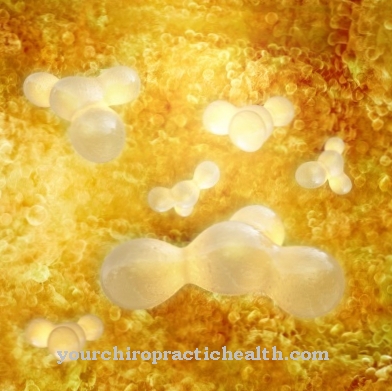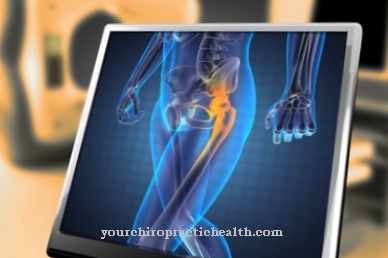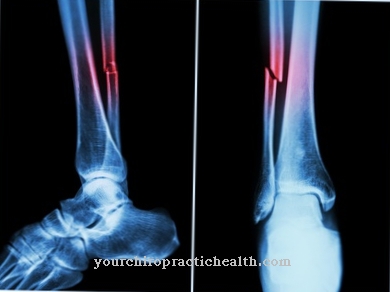The Mechanoreception includes in humans all senses that are excited by mechanical stimuli. They are important for the perception and control of life processes.
What is the mechano reception?

Mechanoreceptors are specialized nerve cells that respond to specific mechanical stimuli. They are located in various tissues, organs and parts of the body and together make up the system of mechanoreception.
Exciting signals can act from outside (exteroception) or inside the body (interoception), whereby the types of mechanical effects can be pressure, stretching, tension, contact, movement or vibration.
The stimulus-absorbing structures of the nerve cells are designed in such a way that the stimulus for which they are specialized leads to a configuration change on the cell membrane, which either directly or indirectly triggers an electrical potential (action potential) that is transmitted via the nerve conduction to the spinal cord or higher Nerve centers.
After the incoming electrical impulses have been picked up and processed, a stimulus response is sent to the corresponding organs with the initiation of an adequate response. These can be the same organs in which the receptors are located or different ones.
The density of receptors in the same or comparable organs can vary, depending on their importance for the perception and regulation of life processes.Many systems are designed as a control loop in which the feedback after signal input takes place directly from the spinal cord to the successor organs.
Function & task
One task of all mechanoreceptors is the reception and transmission of information to higher centers. In these, the incoming data is processed and evaluated qualitatively and quantitatively. Depending on the strength of the stimulus and its importance for the biological system, they are either only stored, perceived as a sensation, or there is an immediate stimulus response with the aim of reducing or stopping the triggering factors. The reaction that is initiated via the feedback is often a protective reaction.
Stretch receptors exist in many different systems in the body. In the stomach, intestinal and bladder walls, they become aroused as they fill up and, in the first case, lead to a decrease in the feeling of hunger, in the second they trigger the purging process, in the third the urge to urinate.
In the tendon-muscle system, stretch receptors are located in the Golgi tendon organ and in the muscle spindle. The tension meters of the receptors are connected in parallel to the muscle and tendon fibers and are excited when the muscle is elongated. They fulfill a typical protective function here by causing the same muscle in which they are located to contract if the stretch threatens to become so great that it can lead to injuries.
The muscle spindle is a highly complex receptor system that is sometimes referred to in the literature as an organ within an organ. While it's in the muscle, it has independent contractile elements that it can use to change the tension in the stretch receptor. In addition to registering voltage changes, the sensitivity of the system can be regulated depending on the motor requirements.
In addition to the pressure, joint receptors also measure the change in angle during movements of the bones belonging to the joint. Together with the muscle spindles, they form an important part of depth sensitivity, which enables the position of the entire body or individual parts, movements and changes in movement and tension to be registered continuously and unconsciously.
Our largest organ, the skin, has a number of superficial receptors, some of which also receive mechanical information. The sense of touch and touch provides information about which materials and substances the skin comes into contact with. In addition to motor responses, this can also trigger emotional sensations. There are also receptors that measure pressure and vibrations. They fulfill a protective function by providing information that leads to the initiation of motor reactions in order to switch off or reduce the triggering stimulus and thereby avoid damage.
You can find your medication here
➔ Medicines for eye infectionsIllnesses & ailments
Disturbances in mechanoreception can either be caused by the receptor itself or by diseases in the areas of the central nervous system that are responsible for impulse processing.
Peripheral nerve lesions mean that the receptors can still take up the stimuli, but not the transmission. No information then arrives in the spinal cord or in higher centers. Accordingly, there can be no reaction or no sensation can arise. A typical example of this is numbness in a certain area that is supplied by sensitive skin nerves. In the case of a herniated disc, the conduction of stimuli close to the point of entry to the spine can be disturbed. In addition to complete numbness in the corresponding skin area (dermatome), abnormal sensations such as tingling can occur.
Polyneuropathy is a disease in which the metabolism of the nerves is attacked, particularly on the periphery of the feet and arms. The protective insulation of the nerve tracts is increasingly being broken down. At first, information reaches the spinal cord in a reduced and slower manner and then disappears completely. In addition to skin sensitivity, the mechanoreceptors of the musculoskeletal system are particularly affected, which leads to a gradual loss of deep sensitivity. The affected people do not feel their feet and no longer have any perception of the position of their joints. For a while, this deficit can be compensated visually. The disease also affects the motor system, which doubles the problem of perception, for example when walking.
Central nervous system diseases such as multiple sclerosis or a stroke can also result in sensitive failures. In most cases, the stimulus reception and transmission by the mechanoreceptors still works, but the incoming signals cannot be processed in the central nervous system or cannot be processed correctly. The consequences are similar to those of a polyneuropathy, but usually much more complex. Not only the peripheral areas, but all areas of the body can be affected.



























